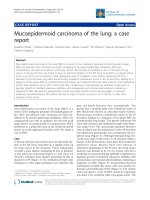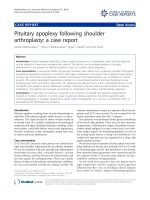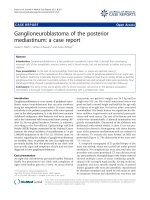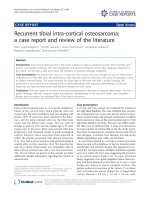Báo cáo y học: " Recurrent spontaneous hip dislocation in a patient with neurofibromatosis type 1: a case report" potx
Bạn đang xem bản rút gọn của tài liệu. Xem và tải ngay bản đầy đủ của tài liệu tại đây (707.2 KB, 4 trang )
CAS E REP O R T Open Access
Recurrent spontaneous hip dislocation in a
patient with neurofibromatosis type 1:
a case report
John G Galbraith
*
, Joseph S Butler, James A Harty
Abstract
Introduction: Neurofibromatosis type-1 is a common genetic disorder which often affects the skeleton. Skeletal
manifestations of neurofibromatosis type-1 inc lude scoliosis, congenital pseudarthrosis of the tib ia and intraosseous
cystic lesions. Dislocation of the hip associated with neurofibromatosis type-1 is a rare occurrence and is
underreported in the literature.
Case presentation: We report a case of hip dislocation resulting from an intra-articular neurofibroma in an 18-
year-old Caucasian woman following minor trauma. This was originally suggested by the abnormalities on early
radiographs of her pelvis and later confirmed with computed tomography and magnetic resonance imaging.
Treatment was successful with skeletal traction for six weeks with no further hip dislocations at a 12-year follow-up.
Conclusion: This case illustrates the radiological features of this rare complication of neurofibromatosis type-1
using the modalities of plain radiograph, magnetic resonance imaging and computed tomography reconstruction.
The radiological images give a clear insight into the mechanism by which neurofibromatosis type-1 leads to hip
dislocation. It also demonstrates one treatment option with excellent results on long-term follow-up.
Introduction
Neurofibromatosis type 1 (NF-1) is one of the most
common autosomal dominant disorders affecting
humans. It is estimated to affect 1 in 3,000 newborns
and 1,000,000 people worldwide [1]. Friedrich Daniel
von Recklinghausen, a German pathologist, was first to
describe the neural involvement within affected tissues;
hence, the association of his name with this disease. It is
a disease involving tissues of ectodermal and mesoecto-
dermal origin, particularly affecting skin, subcutaneous
tissue, peripheral nerves and the skeleton.
The clinical features of NF-1 include: cafb-au-lait
spots, Lisch nodules, axillary freckling, optic gliomas
and peripheral neurofibromas. NF-1 is a disease deeply
relevant to orthopaedic surgery. Patients with NF-1 may
present with characteristic orthopaedic manifestations
such as scolio sis, congenital pseudoarthrosis of the tibia
and limb hypertrophy[2]. Intraosseous cystic lesions,
periosteal bone proliferation coxa valga and protrusion
acetabuli have also been reported [3].
Dislocation of the hip associated with NF-1 is a rare
occurrence. A comprehensive review of the literature
revealed 12 cases of hip dislocation attributed to NF-1.
We report a case of recurrent hip dislocation resulting
from an intra-articular neurofibroma in an 18-year-old
woman.
Case report
An 18-year-old Caucasian woman with a history of NF-1
presented to the emergency department with pain in her
left hip f ollowing minor trauma. She had tripped o ver
her dog and landed on her left side. NF-1 had been
diagnosed clinically in childhood. She had a histologi-
cally proven neurofibroma excised from her right fore-
arm four years previously. She had a strong family
history of NF-1, her mother and three second degree
relatives exhibited clinical features.
On examination, we saw that her left leg was shor-
tened, internally rotated, and adducted. There was
decreased range of movement. She had diffuse swelling
* Correspondence:
Department of Trauma & Orthopaedic Surgery, Cork University Hospital & St.
Mary’s Orthopaedic Hospital, Cork, Ireland
Galbraith et al. Journal of Medical Case Reports 2011, 5:106
/>JOURNAL OF MEDICAL
CASE REPORTS
© 2011 Galbraith et al ; licensee BioMed Central Ltd. This is an Open Access article distributed under the terms of the Creative
Commons Attribution License ( g/licenses/by/2.0), which permits unr estricted use, distribution, and
reproduction in any medium, provided the original work is properly cited.
of her left lower limb with a distinct soft tissue mass
above her right lateral malleolus. She had six cafb-au-
lait patches on her trunk and bil ateral axillary freckling.
A radiograph of the pelvis reveal ed a superior disloca-
tion of her left hip with an abnormal appearing femoral
neck (Figure 1).
Her hip was relocated under general anaesthetic and
this was maintained with skin traction. A computed
tomography (CT) of her pelvis displayed a smooth ero-
sion of the lateral margin of her left ileum and femoral
neck, markedly increased femoral neck offset, a concave
abnormality superior to the left acetabulum and thin-
ning of the left inferior pubic ramus. These changes,
which appeared to be long standing, were acce pted to
be a result o f a local neurofibroma causing bone ero-
sion. Eight days post-operatively she experienced a sud-
den onset of left hip pain on attempting to move in bed.
A radiograph of her hip r evealed repeat dislocation.
Relocation of her hip was performed under general
anaesthetic and balanced skeletal traction was main-
tained b y inserting a pin to her left proximal tibia. Ske-
letal traction was maintained for six weeks. She was
mobilizing without aids at eight week s and follow-up at
three months revealed a normal hip examination.
She presented to the orthopaedic clinic six years later
comp laining of disfiguring hypertrophy of her l eft lower
limb which had worsened markedly over the preceding
two years. She was referred to plastic surgeons w ith a
view toward performing a cosmetic debulking proce-
dure. A pre-operative magnetic resonance imaging
(MRI) scan of her lower limb demonstrated soft tissue
swelling of her entire lower limb consistent with plexi-
form neurofibromatosis (Figure 2). An MRI of her pelvis
displayed a 6 × 4 cm enhancing mass at the superior
aspect of the left acetabulum extending into the l eft hip
joint (Figure 3). There was smooth e rosion of the neck
of the femur but the head of the femur appeared to be
in joint. An MRI of her lumbar spine was normal. A
CT-guided biopsy of this hip lesion histologically con-
firmed it to be a neurofibroma . CT reconstructions
demonstrated no further changes to the bone architec-
ture of her left hip (Figure 4). In view of her lack of
symptoms and the degree of operative difficulty
expected, the peri-articular neurofibroma was not
excised. She underwent several debulking procedures of
her lower limb with excellent cosmetic results. At 12
years follow-up she has experienced no further disloca-
tions of her left hip and mobilizes without aids with a
normal gait. A radiograph of her pelvis demonstrated
her left hip to be in joint (Figure 5).
Discussion
Neurofib romatosis type-1 is a common genetic disord er
that can have both focal and generalized skeletal mani-
festations. Generalized skeletal manifestations such as
osteoporosis and short stature are common. Focal
abnormalities such as tibial dysplasia, short angle scolio-
sis and sphenoid wing dysplasia, although less common,
are well documented in the literature. However, there is
Figure 1 Radiograph of dislocated left hip.
Figure 2 Coronal MRI view of soft tissue swelling of left lower
limb.
Galbraith et al. Journal of Medical Case Reports 2011, 5:106
/>Page 2 of 4
a relative paucity of reported cases of pathological hip
dislocation in patients with NF-1, with only 12 docu-
mented cases found in the published literature. Six dis-
locations occurred following trivial trauma [4-8]and six
cases were deemed atraumatic [9-13].
The suggested mechanism for dislocat ion for the
majority of cases has been related to the intra-articular
growth of neurofibromas [4,5,8,10,13]. Local neurofibro-
mas can lead to deformity of the pelvis, erosion of the
neck of the femur, v algus deformity and joint capsule
laxity, all of which predispose a person to dislocation.
Neurofibromas distant from the hip joint have also been
hypothesised to cause pathological dislocation. Mechani-
cal instability due to weakness of the abductor muscles
caused by s pinal-cord tumors has been suggested as a
predisposing factor [10]. Similarly, neurofibromas can
lead to a deficiency of the normal sensation of the hip
joint leading to a neuropathic arthropathy which can
progress to dislocation [6].
Treatment described has ranged from conservativ e
approaches to definitive sur gical intervention, including
Girdlestone resection [9] and total hip replacement [7].
Despite short-term good results from various treatments
the long-term evidence is lacking, with no follow-up
data longer than six years for any published case.
For our patient her hip dislocation was accepted to be
a result o f a neurofibroma impinging on the hip joint.
This was originally suggested by the abno rmalities on
ear ly radiogr aphs of her pelvis and later conf irmed with
CT and MRI. The CT reconstructions of the hip area
clearly d emonstrate the mechanism by which hip dislo-
cation has occurred (Figure 4). The smooth erosion of
the lateral margin of the left ileum and femoral neck,
the markedly increase d femoral neck offset and the con-
cave abnormality superior to the left acetabulum all
contribute to the instability of the hip joint. The soft tis-
sue swelling responsible for these abnormalities is
clearly demonstra ted on the MRI scan (Figure 3). There
were no spinal-tumors displayed on the MRI of her
lumbar spine. She was treated conservatively with skele-
tal traction. The short term results were excellent and at
12 years follow-up she has had no furthe r episodes of
dislocation.
Figure 3 Transverse and Coronal MRI views demonstrating
neurofibroma above left femoral neck.
Figure 4 CT reconstructions demonstrating erosion of left
femoral neck and pelvis.
Figure 5 Radiograph of pelvis demonstrate left hip to be in
joint.
Galbraith et al. Journal of Medical Case Reports 2011, 5:106
/>Page 3 of 4
Conclusion
This case illustrates the radiological features of this rare
complication of NF-1 using the modalities of plain
radiograph, MRI and CT reconstruction. The radiologi-
cal images give a clear insight into the mechanism by
which NF-1 leads to hip dislocation. It also demon-
strates one treatment option with excellent results on
long-term follow-up.
Consent
Written informed consent was obtained from the patient
for publication of this case report and accompanying
images. A copy of the written consent is available for
review by the Editor-in-Chief of this journal.
Authors’ contributions
JG and JB collected data and drafted the manuscript. JH conceived the
report. All authors critically appraised the manuscript and approved the final
text.
Competing interests
The authors declare that they have no competing interests.
Received: 23 June 2010 Accepted: 16 March 2011
Published: 16 March 2011
References
1. Fienman NL, Yakovac WC: Neurofibromatosis in childhood. J Pediatr 1970,
339:339-346.
2. Crawford AH Jr, Bagamery N: Osseous manifestations of
neurofibromatosis in childhood. J Pediatr Orthop 1986, 72:72-88.
3. Vitale MG, Guha A, Skaggs DL: Orthopaedic manifestations of
neurofibromatosis in children: an update. Clin Orthop Relat Res 2002,
107:107-118.
4. Nakasone S, Norimatsu H, Hamasaki N, Kinjo S, Kinjo Y, Ibaraki K, et al: A
case report of recurrent dislocation of the hip joint with
neurofibromatosis. Seikeigeka to Saigaigeka Orthop Surg Traumatol 1989,
38:511-514.
5. Lachiewicz PF, Salvati EA, Hely D, Ghelman B: Pathological dislocation of
the hip in neurofibromatosis. A case report. J Bone Joint Surg Am 1983,
414:414-415.
6. Phillips JE, McMaster MJ: Pathological dislocation of the hip in
neurofibromatosis. J R Coll Surg Edinb 1987, 180:180-182.
7. Odent T, Ranger P, Aarabi M, Hamdy RC, Fassier F: Total hip arthroplasty in
a patient with neurofibromatosis type I and recurrent spontaneous hip
dislocation. Can J Surg 2004, 219:219-220.
8. Guilleminet M, Creyssel J, de Mourgues G, Fischer L: [Von Recklinghausen’s
neurofibromatosis. Congenital hypertrophy of the lower limb in
childhood and spontaneous luxation of the homolateral hip in adult
age]. Presse Med 1970, 1269:1269-1271.
9. Lampasi M, Greggi T, Sudanese A: Pathological dislocation of the hip in
neurofibromatosis: a case report. Chir Organi Mov 2008, 163:163-166.
10. Haga N, Nakamura S, Taniguchi K, Iwaya T: Pathologic dislocation of the
hip in von Recklinghausen’s disease: a report of two cases. J Pediatr
Orthop 1994, 674:674-676.
11. Endo H, Mitani S, Sugihara S, Kuroda T, Nakahara S, Ozaki T: Nontraumatic
subluxation of the hip after spine surgery for scoliosis in a patient with
von Recklinghausen’s disease. J Orthop Sci 2007, 510:510-514.
12. Lucet L, Elayoubi L, Defives T, Mejjad O, Le Loet X, Cambon-Michot C, et al:
[Anterior pathologic dislocation of the hip in adulthood complicating
Von Recklinghausen neurofibromatosis]. Rev Rhum Ed Fr 1993, 79:79-80.
13. Kuroda M, Nakase H, Yasui N, Ochi T, Takahashi Y, Hirabayashi S: Non-
traumatic dislocation of the hip in von Recklinghausen’s disease: a case
report. RinsyouSeikeigeka (Clinical Orthopaedic Surgery)
1999,
1151:1151-1154.
doi:10.1186/1752-1947-5-106
Cite this article as: Galbraith et al.: Recurrent spontaneous hip
dislocation in a patient with neurofibromatosis type 1: a ca se report.
Journal of Medical Case Reports 2011 5:106.
Submit your next manuscript to BioMed Central
and take full advantage of:
• Convenient online submission
• Thorough peer review
• No space constraints or color figure charges
• Immediate publication on acceptance
• Inclusion in PubMed, CAS, Scopus and Google Scholar
• Research which is freely available for redistribution
Submit your manuscript at
www.biomedcentral.com/submit
Galbraith et al. Journal of Medical Case Reports 2011, 5:106
/>Page 4 of 4









